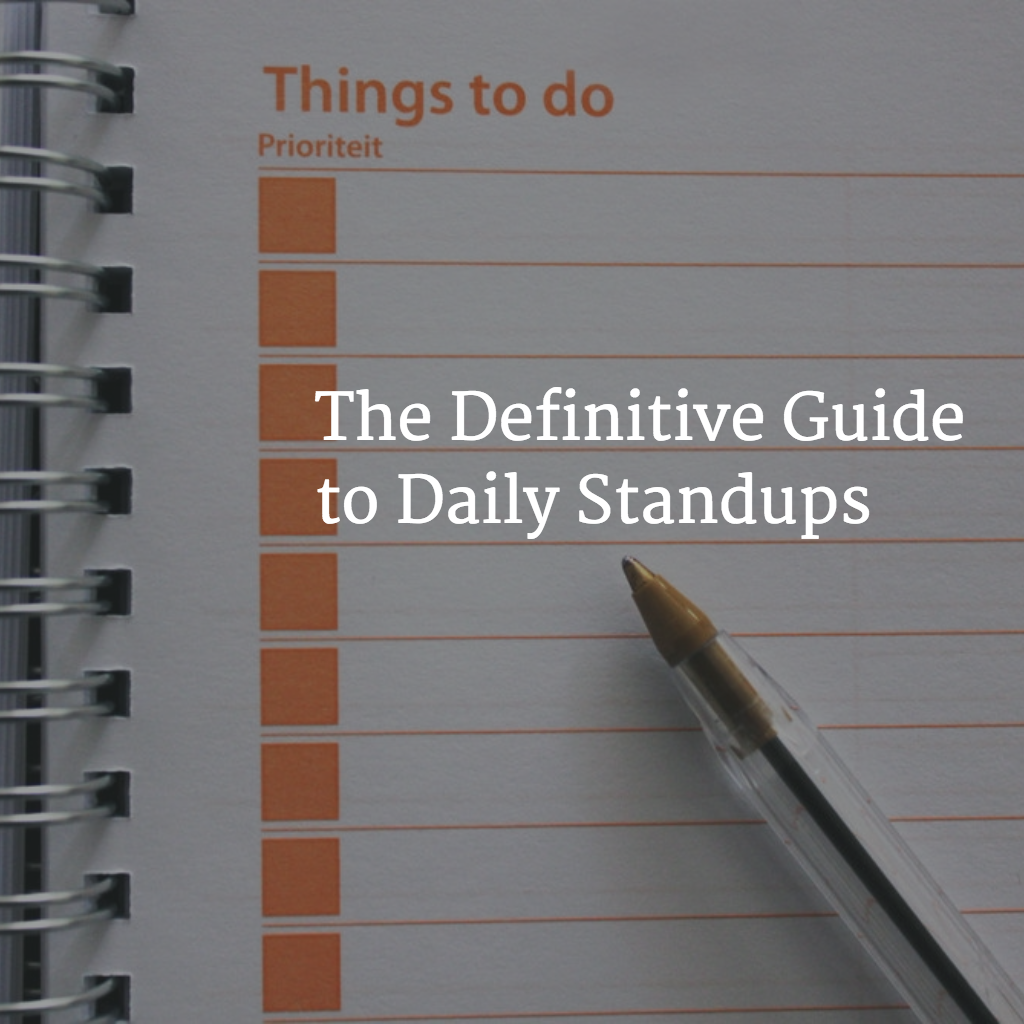When the business world seeks new productivity tools, it often turns its gaze to Silicon Valley, an industry famous for its ability to eliminate the cruft of the workday. But there’s one productivity tool that has its roots not in open-plan offices, but in military strategy boardrooms: the daily standup meeting.
The daily standup has its instructions in the title. It’s a daily meeting where participants stand. That’s it.
Ideally, the lack of chairs promotes a quick and effective meeting. If the conversation prompts a deeper discussion about a specific topic, it’s tabled for after the daily standup.
It’s a technique that American General William Pagonis used during the First Gulf War, where he served as director of Logistics. Each morning, he had 40 officers meet together in a conference room without a table or chairs. It minimized the need for pleasantries and unnecessary comments. Even military officers, it turns out, have a tendency to digress. Pagonis found that the format maximized productivity crucial to military success. Norman Schwarzkopf, in fact, salutes Pagonis as the “logistical wizard” of the Gulf War.
After hanging up is uniform, Pagonis brought this military precision to his corporate job as a Sears executive. He brought workers into a conference room sans chairs and had a quick run-down of the day. Under his leadership, Sears streamlined its business model, cutting delivery times in half. The standup, Pagonis says, was crucial to Sears’ success. When asked why the daily standup was so effective, he said, “When you sit down, a meeting goes for over an hour or an hour and a half, and you lose everybody. When people are standing, they talk faster or they say I don’t have anything to add.” It’s that simple.
The daily stand-up takes a lot of forms. Some offices do it once a week—others, twice a day. Some use chairs, some do it electronically. Some, as it turns out, are more successful than others. This guide looks at how and why daily standups are so effective, and the best way to implement one into your workday.
Why You Need A Daily Standup
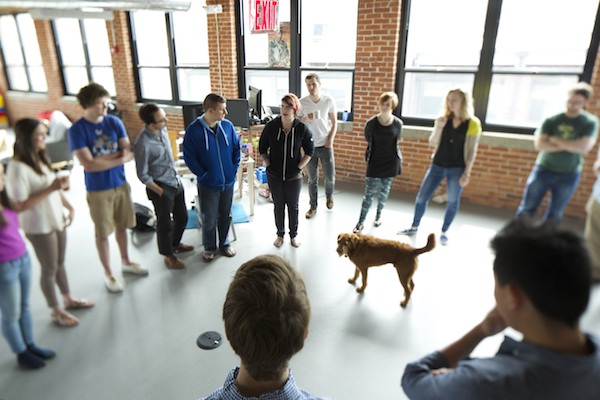
One of the main attractions of the daily standup is that it does away with ineffective meetings. It relays information but does so economically. Standup meetings are 34% shorter than their sitdown counterparts, and one study revealed they don’t impact decision quality or fidelity—employees are just as committed to decisions in daily standup meetings as they are in sitdown ones.
It also solves the problem of information flow that a lot of companies run into. In old school hierarchical companies, information that passed down to employees or up to executives had to travel through middle managers. It created a stopgap. You had to rely on your manager to get information and also to market your accomplishments upward to upper management and the executive team. It was time-consuming and frustrating, as things often got lost in the shuffle.
These days, companies are turning away from that model. Casting itself in the Silicon Valley mold, the modern office values autonomy and often subscribes to a flat management style. But when individuals manage themselves and each other in a peer management environment, it’s vitally important that everyone gets the requisite information flow they need to do their jobs. They must have channels to market their own accomplishments and results.
The office daily standup offers that channel.
It helps managers gather and share data, and does it all transparently, allowing everyone in the company to see what’s going on. This demystifies the black box of the notoriously fuzzy production process — in which raw material turns into output with the application of labor — and makes it possible to measure, analyze, and recognize progress.
The Process
The details of a daily standup change from office to office. Some are only a standup in name—keeping the brevity of a standup meeting but doing it in chairs for the sake of comfort or convenience. Some teams go in the opposite direction, passing around a medicine ball that whoever is speaking must hold parallel to the ground, arms extended. If they feel the weight from the medicine ball is overbearing, they’ve been talking for too long. It’s a reminder to keep it short (and maybe get an arm workout in while they’re at it).
While there will be differences from office to office, there are a few things your standup must include.
- Even if you do your daily standup sitting down, keep the energy of a standing meeting. This means no computers allowed. Participants shouldn’t have screens in front of them as it distracts from the issue at hand.
- All team members must be present. The point of a standup is to communicate information across a swath of people, not an exclusive team within your team.
- Speakers should prepare in advance what they’re going to say to eliminate time spent thinking during the meeting.
- If any digressions come up, speakers must table them to the end of the meeting, or schedule smaller meeting group subsets.
- Everyone must answer three questions:
- What did you get done yesterday?
- What are you working on now?
- What isn’t going well, and what could you use help on?
This last question is the most important. It’s not enough to be self-congratulatory by patting ourselves on the back for what we got done. Part of the benefit of a standup is that the entire team is there, and they can help people in areas where they’re struggling.
It’s also important to maintain a positive environment for your daily standup meeting. When done wrong, standups can feel like big brother monitoring, implying inherent mistrust in employees’ capability to manage themselves. Daily standups are less about tracking employees than they are about sparking a back-and-forth—make sure the language and tone you set are friendly.
Why Standups Work
Part of the power of the standup is in getting your team face-to-face. It can feel counterintuitive, especially if employees prefer doing the bulk of their work individually. As Eric Lee of Microsoft writes, holing up in individual projects is appealing, but ultimately doesn’t work. “I’m not sure that model ever worked all that well,” he says, “but in any case, we (should have) outgrew it a long time ago. It’s simply not workable these days when you consider the speed and volume at which our customers expect us to deliver value. Talk or die. The choice is that simple.”
In addition to the communicational benefits of the standup, the tool helps individuals have a better understanding of their own time. By requiring people to come to the standup with something already planned to say, they’ve spent time personally reflecting upon their own productivity.
As it turns out, setting aside time on a daily or weekly basis to reflect on the day is a powerful productivity hack. In The Progress Principle, Harvard Business School professor Teresa Amabile and colleague Steven Kramer showed the counterintuitive conclusion that progress toward a meaningful goal is the #1 motivator for employees at work, not financial motivation or downward pressure. Professor Amabile prescribes 5 minutes per day of reflection, religiously protected by bosses, centered around the progress and the setbacks of the day. Simply put, employees connected to their work and its progress are happier and more productive.
Case Study: How Standups Helped Imagine Easy Solutions Get A Unified Vision
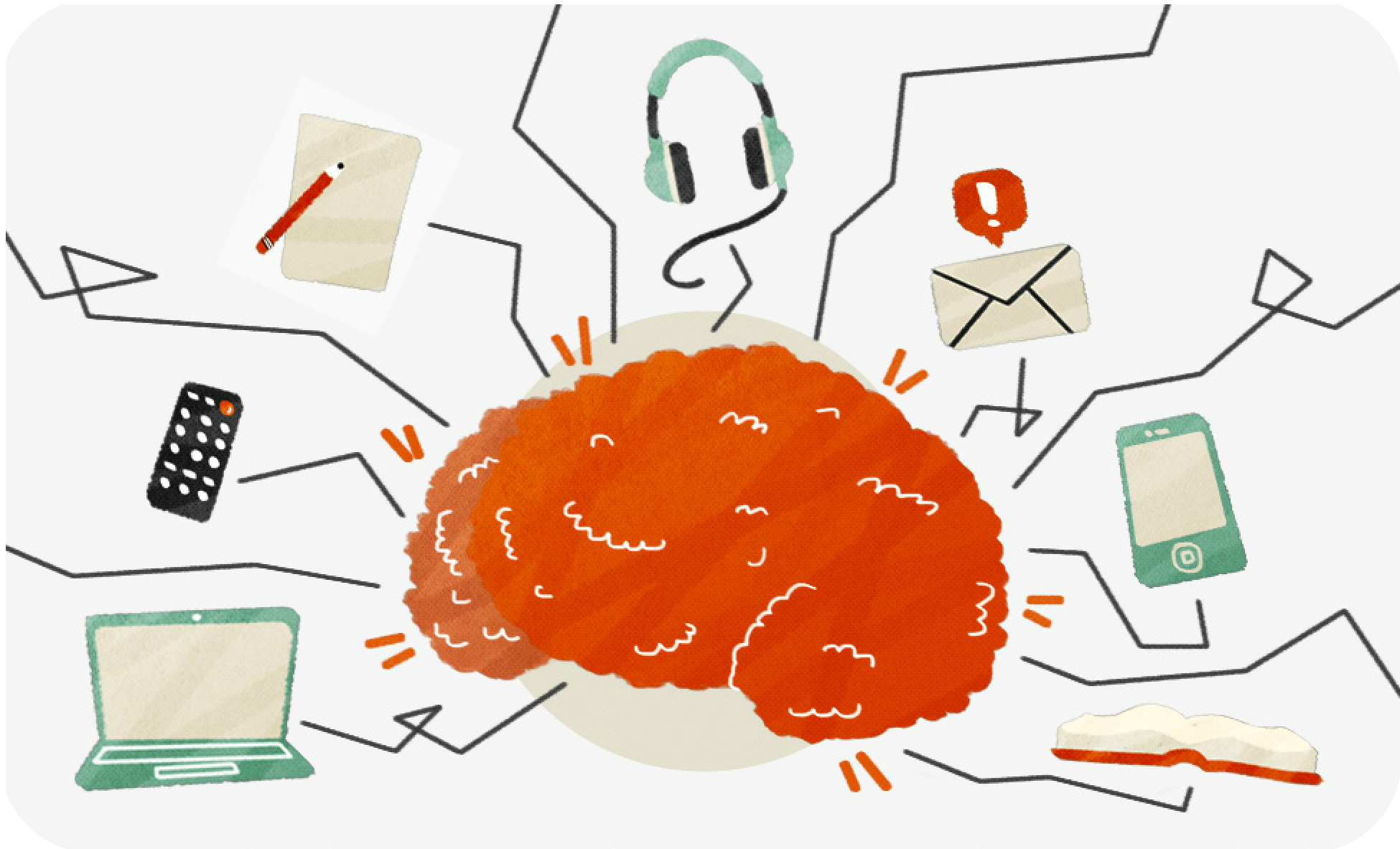
Neal Taparia, CEO of Imagine Easy Solutions, was spending too much time in meetings. He valued getting one-on-one time with his employees, but it was eating into too much of his day. By implementing a daily standup, he cut down his meeting times by 25%, and made meetings more effective and targeted. One employee remarked that when the entire team is in the room together (and feeling a bit uncomfortable without their desk chairs) they “feel a shared purpose to get things done.” Bringing the team together physically helped bring the team together strategically.
It also solved another problem in their workplace meetings: screen distractions. When people on Neal’s team were on their computers during meetings, they were often doing other work. They had Slack notifications popping up, or iMessages, or emails. As the Harvard Business Review reports, multitasking is simply a myth. When people have devices in front of them in a meeting, they might think they’re getting two things done at once, but in fact, they make 50% more mistakes.
Taparia fixed this inefficiency by banning devices altogether. It’s hard to get distracted computer screen when you’re not in front of one. By getting rid of devices, his team had a completely unified vision. Not only did they have a shared purpose, they were all on task.
Case Study: How Atomic Object Uses Daily Standups for Transparency
Software company Atomic Object uses a surprisingly low-tech tool to run a high-tech business: a chalkboard. It’s the road map they use for their daily standup, which takes the form of a morning meeting. The chalkboard allows for total transparency and open communication. Anyone can contribute. The only rule: notes can’t be anonymous. As Vice President Michael Marsiglia writes: “Throughout the day, as ideas emerge, all employees are encouraged to add to the next morning’s meeting agenda by placing a short note or keyword on the chalk board. The chalkboard helps direct focus to the most relevant topics at hand.”
It also allows the team to communicate to everyone in the office. As Marsiglia says, “A mountain of new information is published daily. The meeting gives employees a chance to share the information they have personally found most relevant and valuable, which others may have missed.”
Further, it lets people know what’s going on across departments. Instead of siloing information, it’s visually laid out in front of them. By communicating information in a daily standup—and having the chalkboard available for view in the office all day—they’ve developed a truly transparent office environment.
The Pitfalls
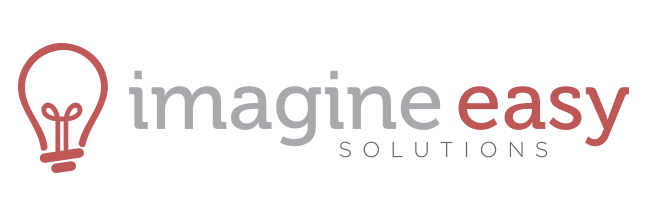
Despite all the benefits of the standup meeting, there are a number of downsides. For one, there are no minutes. While it makes meetings go by faster, it means that there isn’t always a concrete record of what happened. If you do have minutes, they’re often imperfect because the meetings go so quickly. The Imagine Easy HR manager found that because meetings happened at such a quick pace, she often had to return to people to confirm details—or just got them wrong.
What’s more, some people don’t get the chance to speak. The quick daily standup meeting favors team members who are bold and vocal and often neglects those who are shy and don’t raise their voice. This means that your team isn’t working to their potential—not everyone is contributing at capacity.
Another problem is that daily standup meetings often digress. Even though they’re meant to be kept short, they’re often uncapped and end up becoming the starting point for a much larger and deeper conversation that defeats the purpose of a quick meeting. Let’s say your team is working on a project. You have a creative team and a technical team. When everyone gets in the room together, it doesn’t make sense to discuss the technical aspects of the project when half the people in the room have nothing to contribute and nothing to learn. While they certainly could benefit from a cursory understanding (i.e. the quick rundown that’s communicated during an effective standup), listening to other employees talk about the small details of their work is a waste of their time—and your money.
Here’s the real clincher with daily standups: scalability. When you get to large teams, the system falls apart. If you work with a lot of people, it simply doesn’t make sense to have each person speak individually, since it takes up too much of everyone’s time.
Mark Pincus, CEO of the game distributor Zynga, really values face time, as it allows for better management. He used to do the kind of one-on-one mentorship and whole team meetings that Atomic Object does. But as he writes, “You can manage 50 people through the strength of your personality and lack of sleep. You can touch them all in a week and make sure they’re all pointed in the right direction. By 150, it’s clear that that’s not going to scale, and you’ve got to find some way to keep everybody going in productive directions when you’re not in the room.”
What’s more, when companies do try to scale meetings, they run into a problem: the inefficient meeting. Meetings are a helpful tool to decide and plan things. But misused, they leave workers with little resolved and nothing to show for it but a bunch of meaningless minutes. Recently Harvard Business School professor Nancy Koehn talked to NPR’s Marketplace about ineffective meetings. The estimates she cited include:
- 11 million meetings every day in the U.S.
- That means $4 billion a year.
- Over 50% of people surveyed said that half the meetings they attend are unproductive.
- That’s $2 billion ineffective meetings.
Want more depressing stats? Kiss $37 billion goodbye. That’s how much unnecessary meetings costs businesses every year according to the U.S. Bureau of Labor statistics. And most meetings—two-thirds of them to be precise—end before decisions are reached.
Why You Need Asynchronous Standups

So how do you get the benefits of a standup without the downsides? Enter Google Snippets.
During Google’s growth stage, Larry Schwimmer, an early software engineer, stumbled upon a solution that was deceptively simple, but it’s one that persists to this day at Google and has spread throughout the Valley. In his system called Google Snippets, employees receive a weekly email asking them to write down what they did last week and what they plan to do in the upcoming week. Replies get compiled in a public space and distributed automatically the following day by email.
The power of Google Snippets, then, is not just that it’s a standup. It’s that it’s an asynchronous standup. The main reason Snippets works is because it’s minimally disruptive to employee flow. It works asynchronously and without facetime, which allows for a maker schedule — large blocks of time dedicated to concentrated progress on work. It doesn’t break up an engineer’s day into a manager’s schedule to suit a manager’s needs. In addition, email as an interface avoids the issues with, for instance, CRMs, where employees spend valuable time logging into a system and entering highly structured information—a barrier so high that it sometimes results in people not using it at all.
Put differently, Google Snippets is a management process that scales because transparency means that individual engineers can manage themselves and individual engineers can manage each other without having to go through a middleman. Its asynchrony gives it the disruptive power of peer-to-peer management centered around atomic units of work.
Not only do you need to implement a standup in your workday, it needs to be one that’s disruptive and encourages peer management by being asynchronous.
The Process
Like in-person standups, the asynchronous standup can take a number of forms. The principles are the same: employees answer questions about what they got done, what they’re working on, and what they could use help with. Google Snippets requires users to send their manager a weekly email with this information. Other offices do the same thing, but with a daily email.
The problem with using private email is that unless everyone is carbon copied, the information is only conveyed between two people: employee and manager. It’s important to note that even if your standup is asynchronous, it should be transparent—information that team members relay to managers should be relayed to everyone.
Many companies solve the problem of transparency by using external tools like I Done This to communicate their standup. I Done This has users reply to an evening email reminder with what they did that day. The next day, everyone receives a digest with what everyone on the team got done, thus increasing transparency.
Asynchronous standups are immensely powerful for a number of reasons. For one, you don’t just get the minutes of a meeting: you have the actual transcript. Not to mention, the process of writing is in fact immensely helpful in thinking through ideas. Former Intel CEO Andy Grove calls writing “a safety-net” for your thought process. Grove also found having managers write reports at Intel forced the manager’s thinking to be more precise.
“As they are formulated and written, the author is forced to be more precise than he might be verbally,” Grove wrote. “Hence their value stems from the discipline and the thinking the writer is forced to impose upon himself as he identifies and deals with trouble spots in his presentation. Reports are more a medium of self-discipline than a way to communicate information.”
The idea of “maker’s time” is also incredibly important, especially when employees are doing creative work. Dividing up the workday can be burdensome and prevents creative thought and productivity. By protecting your employees’ “maker’s time,” you’re encouraging them to do their best work.
Case Study: How Wistia Protects Its Employees’ Creative Time
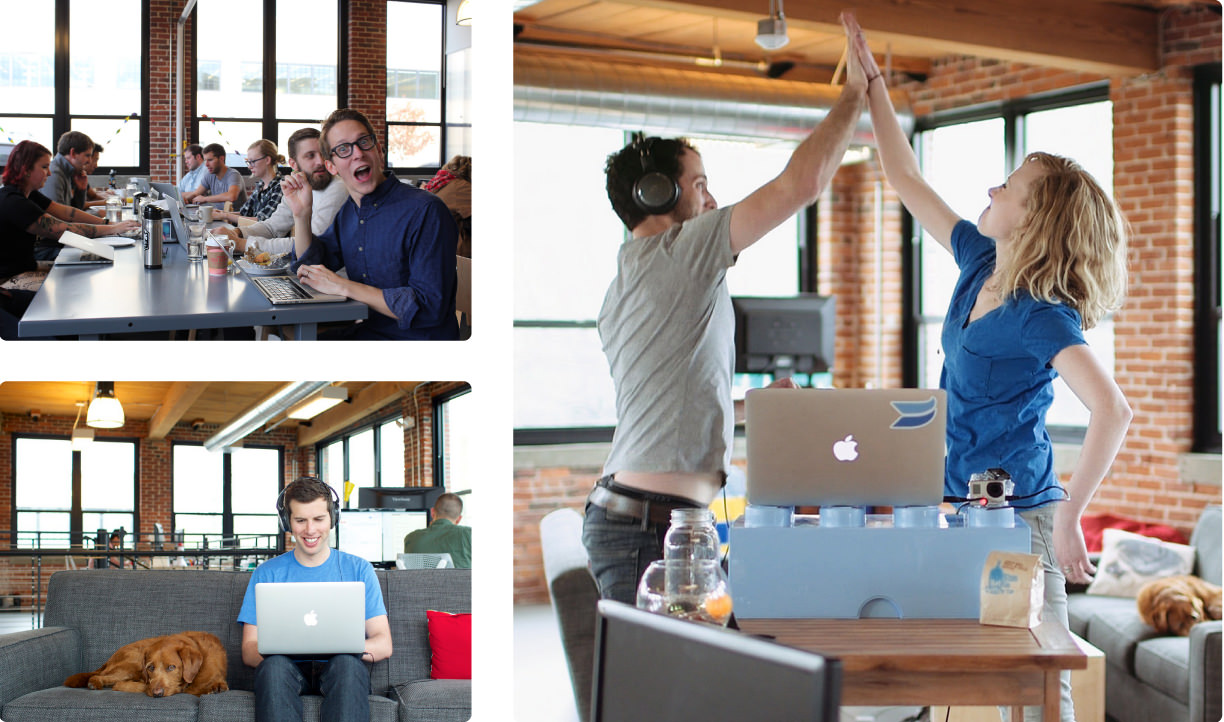
It’s a problem Chris Savage of Wistia kept running up against. Regular meetings, he found, broke up his employees’ workday in a manner that prevented them from getting the most done. Without large blocks of uninterrupted time, people couldn’t complete their projects. Chris needed a better way to communicate with his team.
When Wistia grew rapidly, they were having a hard time staying productive. Chris pointed out that Wistia’s “internal communication mechanisms have had to evolve so that they are less disruptive, more relevant, and more helpful.” Allotted ample ownership and authority, people at Wistia have a great deal of freedom over what they do. As a result, as Chris explains, “it’s hard to know what everyone else is doing, which I think is really important.” He implemented a new leadership strategy: protecting his employee’s creative time.
This required a number of small changes to how they went about business. The Wistia team relies on tools like Yammer to keep the productivity engine running and continues to hold weekly stand-up meetings, but specifically for announcing goals for the week. They also use iDoneThis to “facilitate what would often be those random connections that would happen if you were sitting next to somebody, if you were walking by somebody working on something.”
It’s allowed Chris to protect his employee’s creative time, which is particularly important to Wistia. The team is proud of its distinctive company culture and the deliberate effort with which that culture is cultivated. Chris elaborates, “A big thing we wanted to do was start to write it down and talk about it and have a vocabulary because we felt like if we don’t fight for it, we won’t be able to maintain it. It actually feels like a competitive advantage.”
Part of building that company culture meant defining a company identity, or the “Wistia way” of doing things. When Wistia launched a free version of its service, for example, they created a rap video instead of simply sending out an email and adding the plan to the pricing page. They did it the Wistia way: “Go a little over the top, have a lot of fun with it, and express our own excitement.” In order to make that happen, they needed to figure out a business strategy to allow them to get creative.
Case Study: How Buzzfeed Uses Asynchronous Standups for Transparency
Jon Steinberg, president and COO of Buzzfeed calls his weekly standup (which they also call Snippets) a “kismet engine.” Its primary benefit, in Steinberg’s eyes, is that it allows for collaboration across teams. Everyone can also subscribe to each others’ snippets, regardless of what their role is. As for Jon, he reads his compiled snippets over the weekend and then responds with feedback and questions. He explains this makes it possible to “connect dots and people on things I wouldn’t otherwise know about.” Voilà, facilitated kismet.
Depending on what’s going on, that kind of transparency may show you something wonderful or ugly or what’s sticking out. Getting a view of the picture’s composition is revealing and full of insight. And it’s a good deal better than the alternative of merely having a random, vague sense of what’s going on, only seeing some percentage of the whole. It certainly worked for Buzzfeed.
Why Your Remote Team Needs to Communicate More

In 2013, Yahoo CEO Marissa Mayer famously eliminated the company’s work-from-home policy. In one of her many defenses of the change, she conceded “people are more productive when they’re alone…but they’re more collaborative and innovative when they’re together. Some of the best ideas come from pulling two different ideas together.”
The truth is, more and more Americans are working from home. What’s more, the Harvard Business Review reveals that it’s just as productive—if not more so—than working in an office, but only when done properly. The question, then, is how to resolve Mayer’s quandary. How do managers reap the benefits of the productivity of working from home, but maintain the collaborative effect of working in and communicating with a team?
The answer? Standups.
The growing number of remote teams means that team managers have to rethink how they go about their work day. Without the conventional trappings of a workday—like an office or a commute—remote teams are questioning and reimagining the future of work. While there are a number of tools offices can now use to help communicate during work even if they aren’t together, the asynchronous daily standup is the only way to make sure everyone is communicating. Remote working is still difficult—check out our complete guide to it—and standups are just a part. But an important one—especially if everyone is making their own schedule or lives in different time zones. Your daily standup is the way to solve any miscommunications.
Whether people are located in one office, at home, at a coworking space, or coffee shop, everyone has to work together to effectively communicate and collaborate. And when it comes to communication tools, as Jamie Wilkinson of VHX said, “It’s a question of having a good Swiss army knife … having small tools that do certain things really well.” It’s important to compile the right kind of tools—including an asynchronous daily standup.
Case Study: How Buffer Uses I Done This to Promote Trust
Buffer is a San Francisco-based company with a virtual office that uses I Done This as one of the tools in their Swiss army knife. For them, its primary function is to promote trust even when their team isn’t all in a room together. In fact, they go to extremes to educate the team on the needs of its members. At Buffer, everyone knows what everyone is working on, what everyone is trying to improve on, what everyone on the team is reading and even how much everyone on the team slept and how much they make in salary.
The Buffer team uses I Done This to share all of their personal and professional information to be radically transparent with each other. This builds an incredible amount of trust and intimacy in the team which is fundamental for communicating freely and making loneliness a thing of the past—but can be a problem in remote work.
I Done This also makes the Buffer team more productive by showing everyone that they value and appreciate each others’ work—which can actually make a dramatic difference in a team’s happiness and productivity. And it’s as simple as saying “nice job!” to someone that’s feeling disconnected from the team dynamic.
Case study: How Talko Uses Standups to Manage a Remote Team
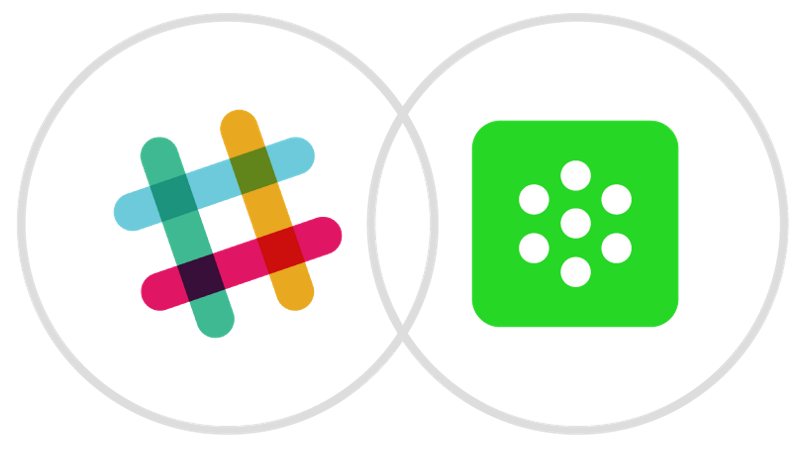
Communicating across a team is hard—especially when the team is spread out across three cities and two time zones. It’s a problem facing an increasing number of companies, as the number of remote workers grows every year,
Talko has a team of 11 people, with about half in Boston and the rest divided between San Fransisco and Seattle. Talko is a tool for holding one-on-one and team calls wherever you are. It’s designed to work great while mobile, including in and across highly variable mobile networks. The calls can be recorded, tagged and interjected with photos during the call. The whole call and supporting data is then stored and can be easily searched or shared. The company was founded by former Microsoft Chief Architect Ray Ozzie along with Matt Pope, who heads up product, and Eric Patey, who heads up engineering.
But the tool they’ve created isn’t enough to get their communicating done. When the team at Talko gets together for their daily standup meeting, they turn to three tools to get the job done: Talko, I Done This and Slack.
Or as the Talko team wrote in a recent blog post on Medium: “We use I Done This to log what each team member has done and will do. We’ve used and loved it for years now. By the time we do daily standup, we know that everyone has seen ‘just the facts’ regarding dones and to-dos. So we focus our daily standup time exclusively on issues, blockers or questions. It’s efficient.”
3 Ways To Make Sure You’re Communicating Well
Remote teams don’t have a common office, so they need to find a common ground. “One thing that excites me about building a company is the human experience of making something out of nothing together,” our co-founder and CEO Walter recently wrote in a company email. As a distributed company, we have to sweat to achieve that communal sense of creation, but in doing so, we’ve had to consider and resolve aspects of our work culture with deliberation.
Culture takes shape from a sense of coherence, built through shared experiences, expectations, and values — and one key to cohering is learning how to communicate effectively with each other. Here’s what we’ve learned about remote team communication that deals with building those shared relationships, expectations, and values and that help shape the cultural foundation of how we get stuff done.
1. Make sure that you’re closing the loop.
One of the great advantages of remote teams is the ability to work asynchronously, giving people the time and space to focus without disruption. However, with asynchronous communication, it’s tough to settle the problem of discovering you’ve sent a message out into the void.
2. Always have a clear purpose for any remote team communication tool or process.
The best remote teams aim to over communicate. They use an arsenal of remote team communication tools to make up for how information travels around an office, providing channels for the various types of conversation that take place in different spaces, such as brainstorming around the whiteboard or chatting in the break room. The calculation of which tools and processes to use as a remote team requires understanding their roles and functions.
3. Make room for emotional conversations.
Informal conversations are more difficult and important than you might think when it comes to co-worker communication. Most remote teams use tools like HipChat or Campfire for water-cooler conversation, where off-topic jokes, banter, and chatter can take place in addition to work-related discussion.
Emotional communication and how we deal with each others’ feelings is a tremendous part of building morale, a sense of togetherness, and culture — and that’s a key factor for remote teams to consider in how they work. Figuring out how to working effectively as a distributed startup is a constant process. We learn from our experiences and our mistakes, not to mention the brightest distributed companies like Buffer, Zapier, LKR Social Media, and Sqwiggle who write and share so thoughtfully about the subject.
The Future of Workplace Standups
The shape and form of the workplace are changing. Not only is remote work on the rise, but as work gets automated and outsourced, self-directed, creative work is required in ever-increasing degrees. Peer management not only makes us more efficient, but it builds a workplace that enables autonomy, mastery, and purpose that makes work fulfilling and joyful. It’s clear that this trend is on the rise, and it’s only going to continue.
But as major companies like Buzzfeed, Wistia, and Palantir have discovered, peer management can tricky to navigate. It can be hard to get stuff done without bossing people around. Tools like the daily standup—particularly the asynchronous daily standup—offer managers a much-needed compass in these uncharted waters. It’s hard to steer the team in the right direction when you yourself don’t quite know what to build—or how to communicate with them.
Luckily, we have reason to be optimistic. Not only do these changes to the workplace offer the potential for greater fulfillment and joy at work, but there are a number of tools in place that will make them incredibly functional. If we focus on eliminating the cruft by increasing communication, we can work hard, work smart, and work happy.
Photo credits: Marc Gutierrez, Wistia, Handshake, Digital Trends
P.S. If you liked this article, you should subscribe to our newsletter. We’ll email you a daily blog post with actionable and unconventional advice on how to work better.

